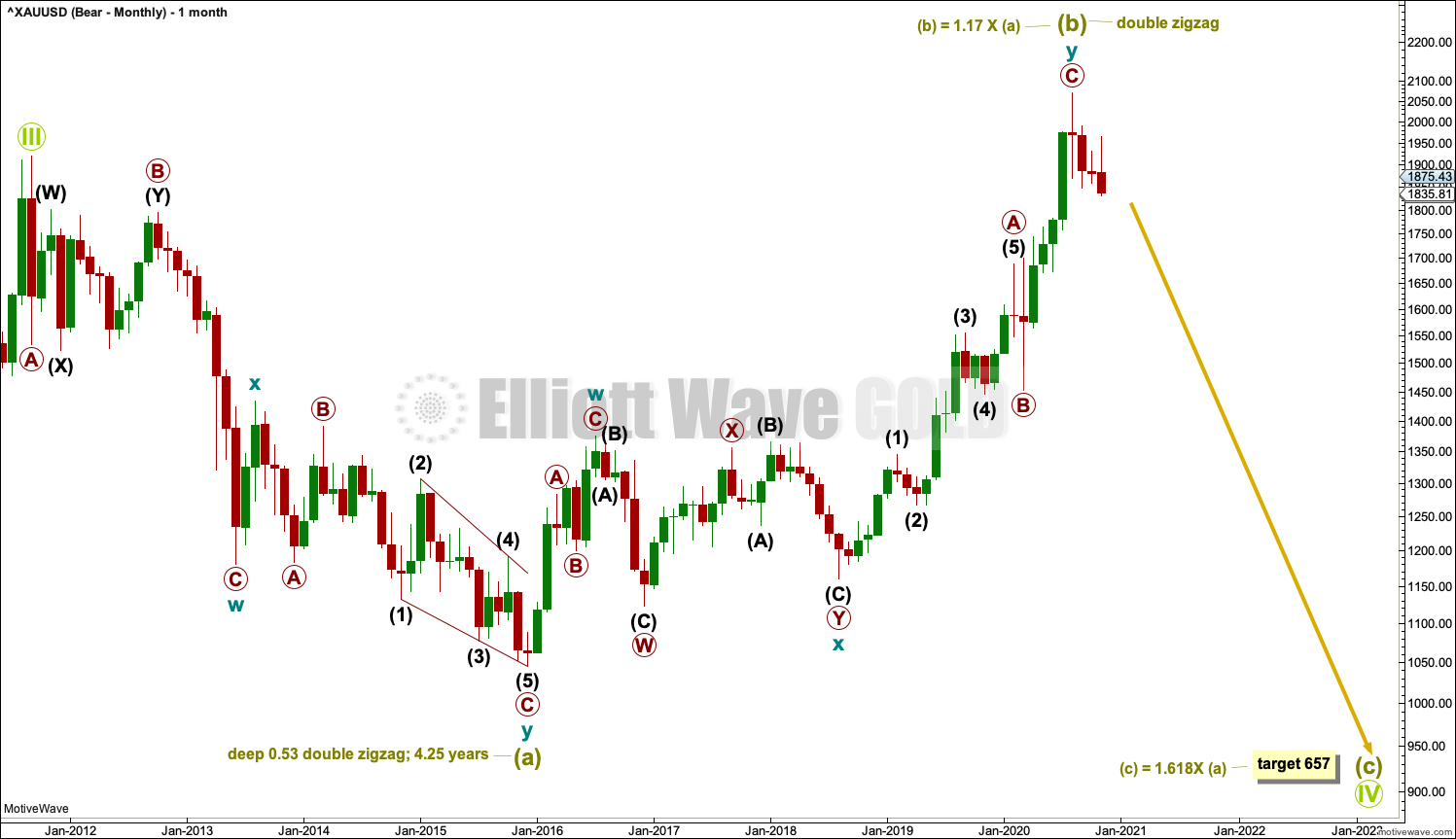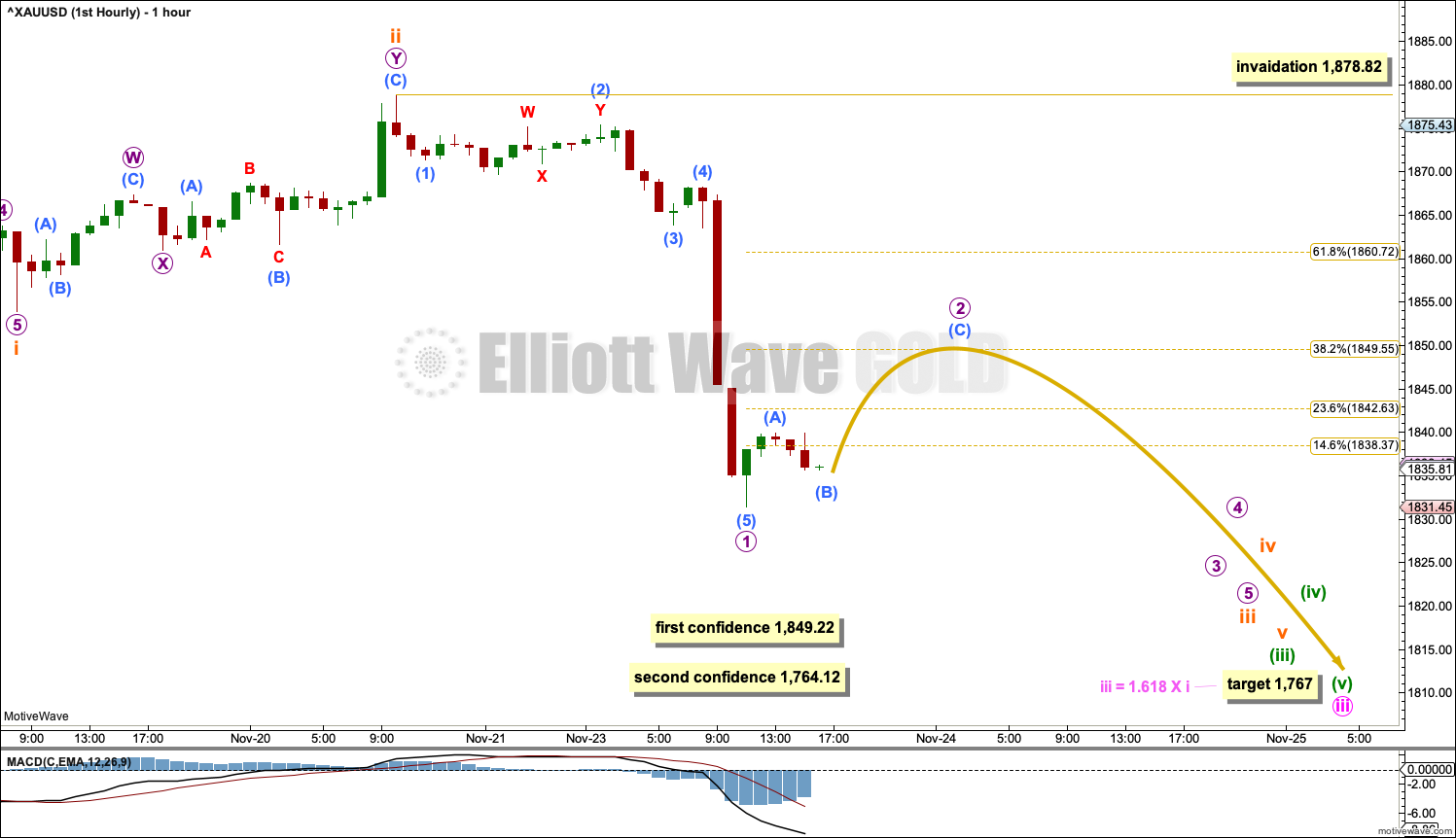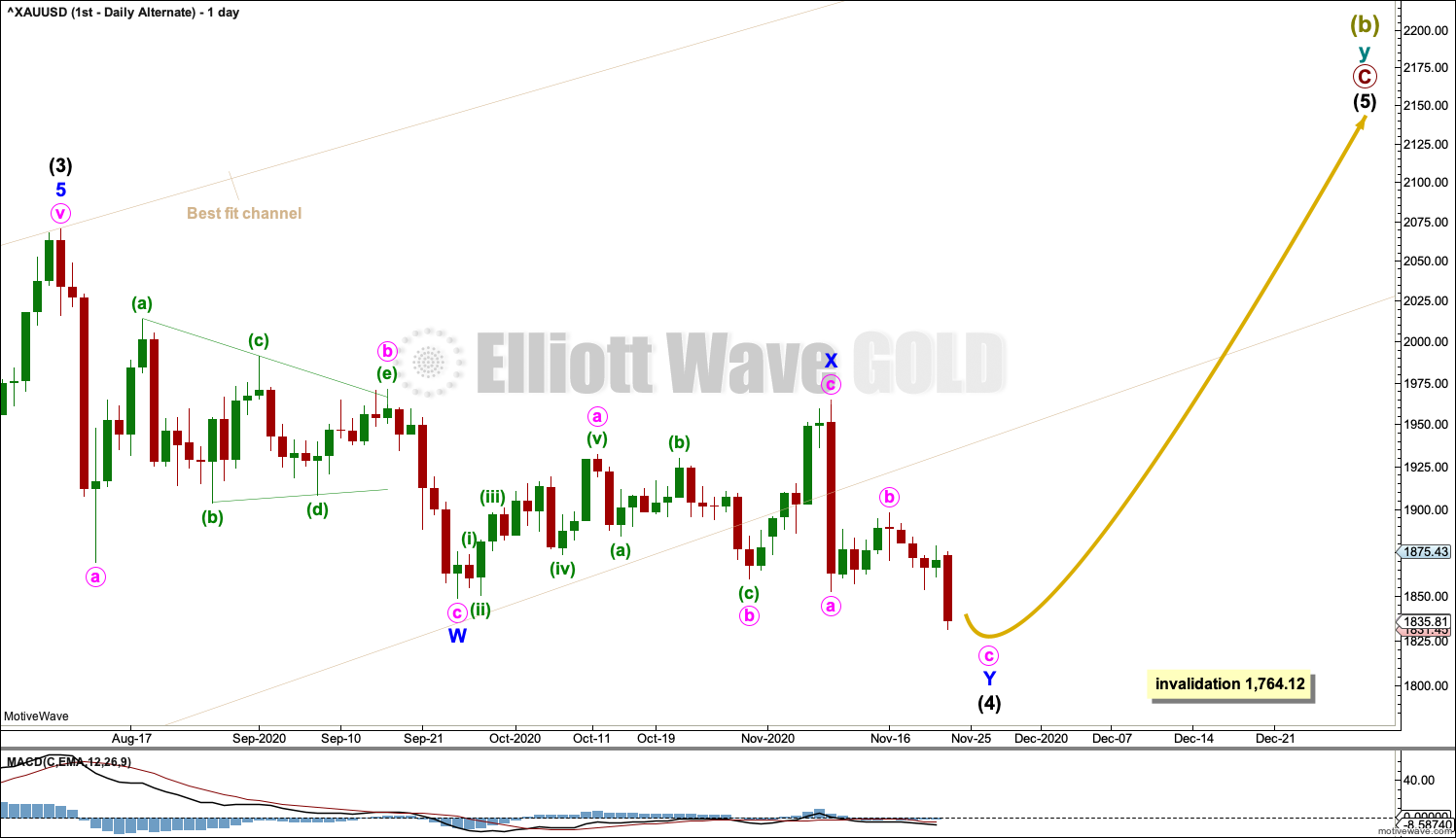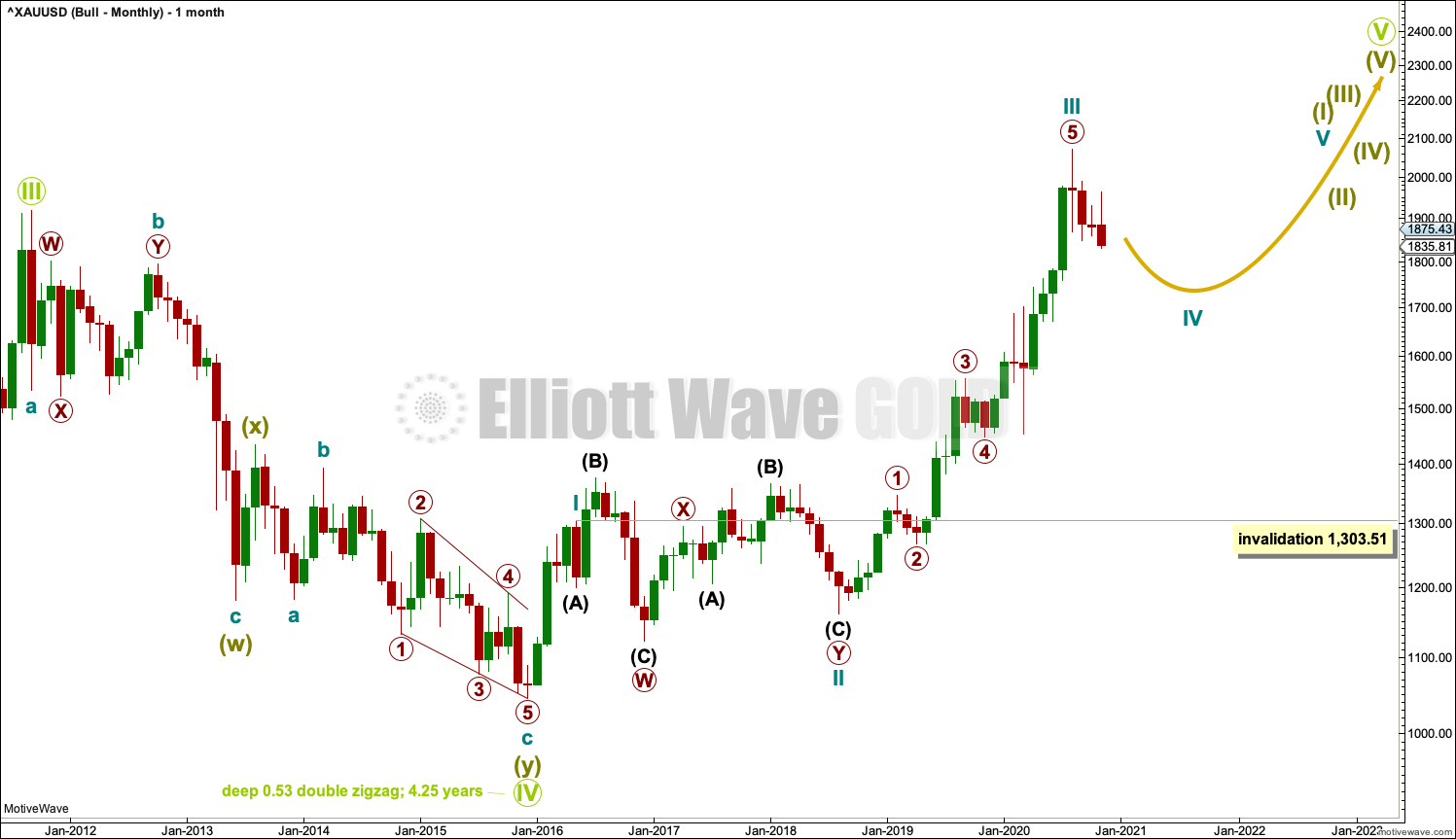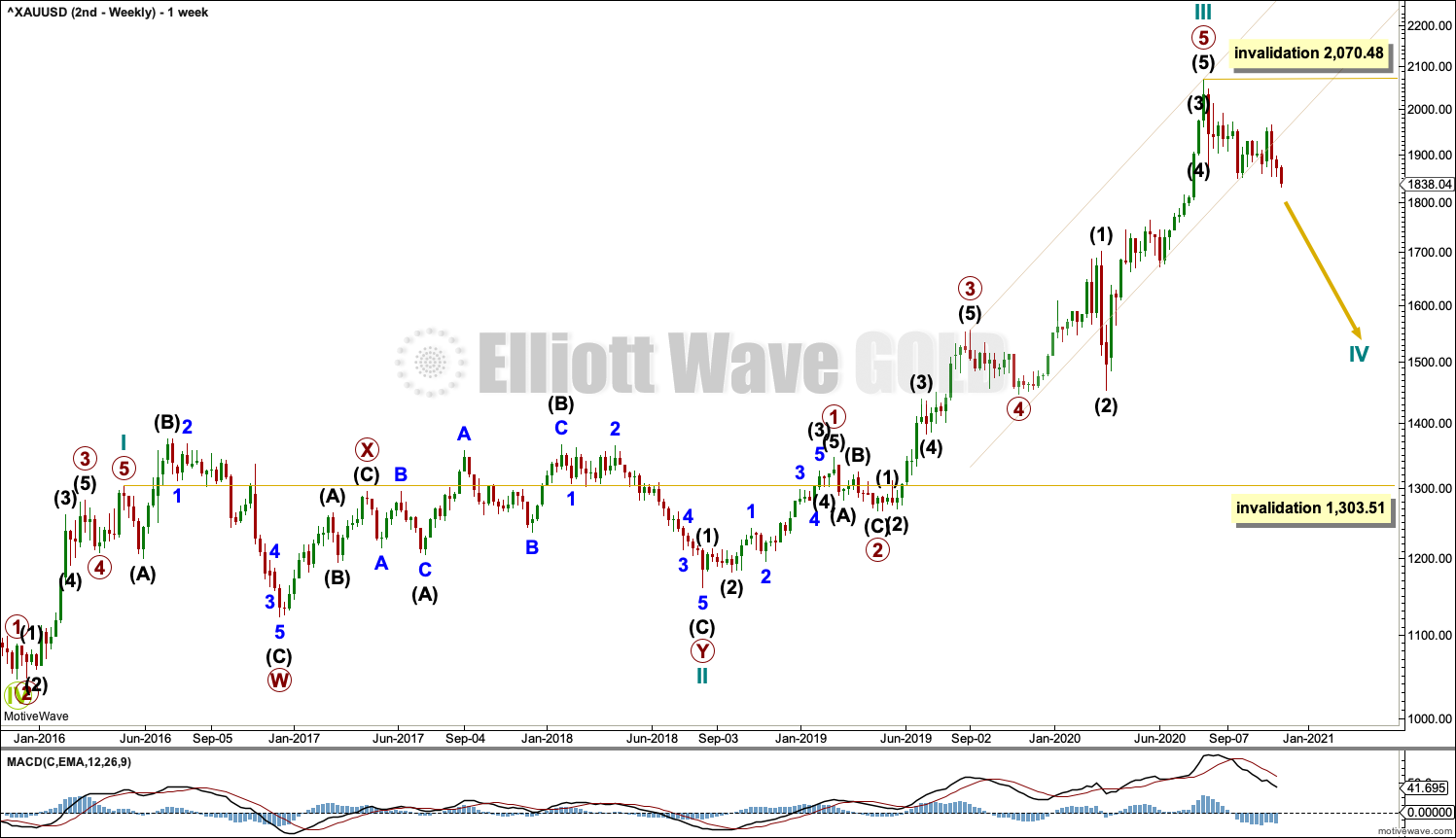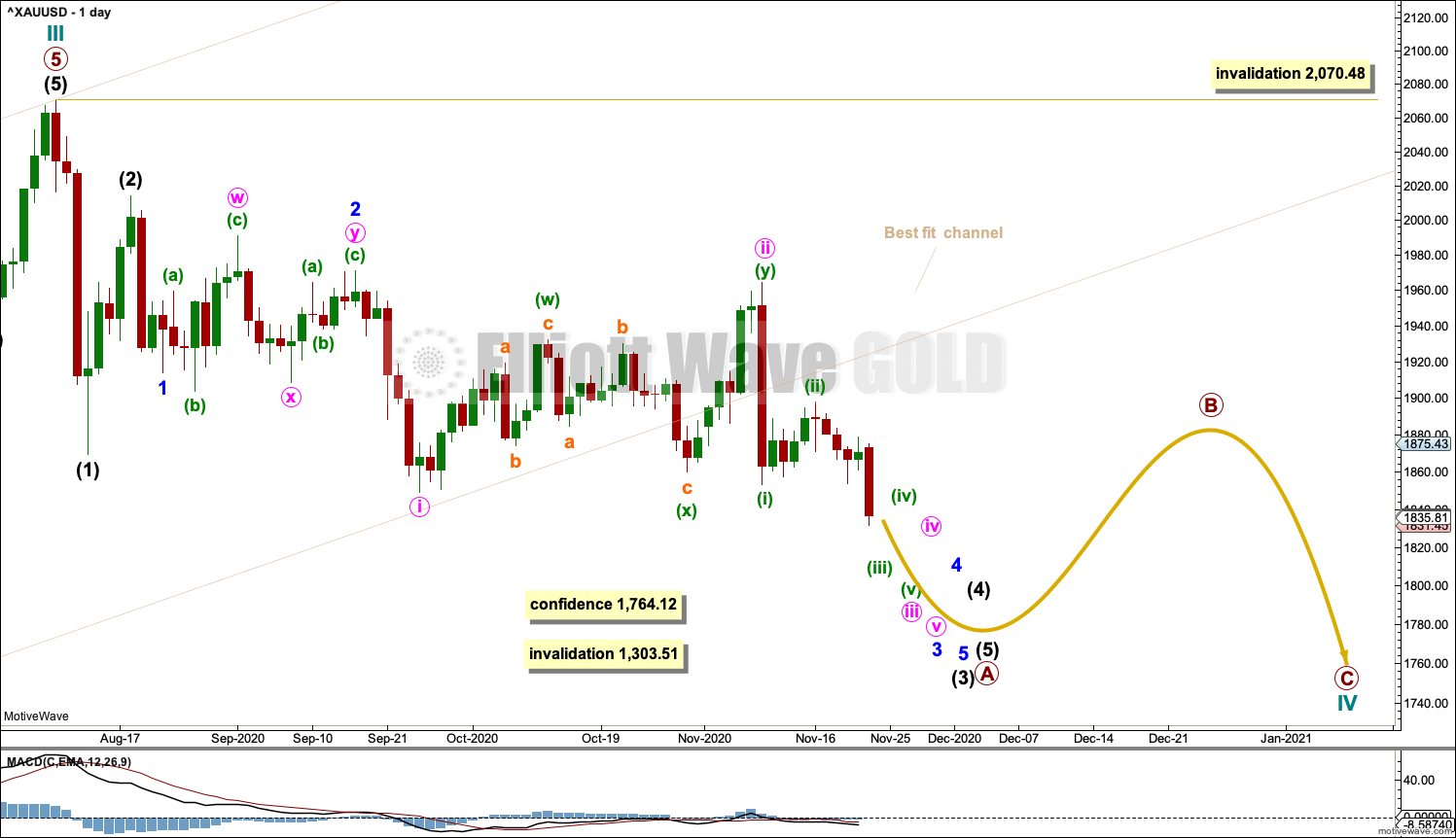GOLD: Elliott Wave and Technical Analysis | Charts – November 23, 2020
For the first Elliott wave count, the main and alternate daily charts are swapped over now that price has indicated which is most likely.
Today monthly charts are updated.
Summary: The first wave count is bearish for the bigger picture, and it has a main and an alternate daily chart. The main daily chart expects a multi-year bear market may be in its early stages to end below 1,046. Short-term targets are at 1,767 and then at 1,709. A new long term target is now at 657. The alternate daily chart has a low probability and would be invalidated below 1,764.12.
The second wave count is bullish for the bigger picture. It expects a multi-month to multi-year bear market that may be in its early stages to possibly end about either 1,722.96 or 1,508.27.
Grand SuperCycle analysis is here.
FIRST ELLIOTT WAVE COUNT
MONTHLY CHART
It is possible to see the large downwards wave labelled Super Cycle wave (a) subdividing as a double zigzag, which is a corrective structure.
If Super Cycle wave (a) has subdivided as a double zigzag, then Grand Super Cycle wave IV may be unfolding as an expanded flat correction.
Expanded flat corrections are fairly common Elliott wave corrective structures, particularly in fourth wave positions. The common range for Super Cycle wave (b) within a flat correction would be from 1 to 1.38 times the length of Super Cycle wave (a) from 1,920.18 to 2,252.27. If Super Cycle wave (b) is over, then it is within this common range.
There is no Elliott wave rule stating a limit for Super Cycle wave (b) within a flat correction, so there is no rule to apply to determine an upper invalidation point for this wave count.
A target is now calculated for Super Cycle wave (c) that expects a common Fibonacci ratio to Super Cycle wave (a) within an expanded flat. Super Cycle wave (c) would be very likely to make at least a slight new low below the end of Super Cycle wave (a) at 1,046.27 to avoid a truncation and a very rare running flat.
WEEKLY CHART
The bigger picture for this first Elliott wave count sees Gold as still within a bear market, in a three steps back pattern that is labelled Grand Super Cycle wave IV on monthly charts. Grand Super Cycle wave IV may be subdividing as an expanded flat pattern.
Super Cycle wave (b) within Grand Super Cycle wave IV may be a complete double zigzag. This wave count expects Super Cycle wave (c) to begin and to move price below the end of Super Cycle wave (a) at 1,046.27. The target calculated expects a common Fibonacci ratio for Super Cycle wave (c).
The first zigzag in the double is labelled cycle wave w. The double is joined by a three in the opposite direction, a combination labelled cycle wave x. The second zigzag in the double is labelled cycle wave y.
The purpose of the second zigzag in a double is to deepen the correction. Cycle wave y has achieved this purpose.
A best fit channel is drawn about primary wave C to contain as much of this movement as possible. Copy this channel over to daily charts. This channel is now clearly breached, which suggests the upwards wave labelled cycle wave y may be over.
DAILY CHART
A series of five first and second waves may be complete. A third wave down may now be developing strength.
Primary wave 2 within the new downwards trend may not move beyond the start of primary wave 1 above 2,070.48.
Minute wave iii must move below the end of minute wave i at 1,849.22. It has done this today.
A new low below 1,849.22 adds initial confidence to this wave count. A new low below 1,764.12 would add reasonable confidence.
This wave count expects a further increase in downwards momentum. Either one or both of minuette wave (v) or minute wave v may end with a selling climax. Minuette wave (iv) and minute wave iv may be relatively brief and shallow.
HOURLY CHART
The hourly chart focusses on the developing middle of a third wave, from the low labelled subminuette wave i (which may now be seen on the daily chart).
Subminuette wave iii may only subdivide as an impulse. Within subminuette wave iii: micro wave 1 may be complete, and micro wave 2 may not move beyond the start of micro wave 1 above 1,878.82.
ALTERNATE DAILY CHART
Primary wave C may be incomplete.
Intermediate wave (4) may be continuing a little lower as a double zigzag. Intermediate wave (4) is now grossly disproportionate to intermediate wave (2); intermediate wave (2) lasted 14 sessions, whereas intermediate wave (4) so far has lasted 76 sessions. This disproportion gives the wave count the wrong look and reduces its probability further.
The wide beige channel is copied over from the weekly chart. Price has now breached the channel. This channel breach favours the main wave count.
Intermediate wave (4) may not move into intermediate wave (1) price territory below 1,764.12. This is the final price point which would invalidate this wave count.
ALTERNATE HOURLY CHART
The second zigzag in the double for intermediate wave (4) may be very close to completion.
SECOND ELLIOTT WAVE COUNT
MONTHLY CHART
This wave count sees the large downwards wave from September 2011 to December 2015 as having the same subdivisions as the prior chart above, a double zigzag, but it moves the degree of labelling within the double zigzag up one degree.
It is possible that the bear market for Gold was over at the low in December 2015 as a double zigzag. This would see Grand Super Cycle wave IV lasting only 4.25 years, where Grand Super Cycle waves may be normally expected to last at least a decade and possibly longer. The brevity of a Grand Super Cycle wave reduces the probability of this wave count.
If the bear market was over in December 2015, then a new bull market should have begun there. This is labelled Grand Super Cycle wave V.
Super Cycle wave (I) within Grand Super Cycle wave V would be incomplete and would be subdividing as a five wave impulse, the simplest Elliott wave structure. Cycle waves I through to III within the impulse would now be complete. Cycle wave IV may not move into cycle wave I price territory below 1,303.51.
WEEKLY CHART
This wave count sees the the bear market complete at the last major low for Gold on 3 December 2015.
If Gold is in a new bull market, then it should begin with a five wave structure upwards on the weekly chart.
Cycle wave I fits as a five wave impulse with reasonably proportionate corrections for primary waves 2 and 4.
Cycle wave II fits as a double flat. However, within the first flat correction labelled primary wave W, this wave count needs to ignore what looks like an obvious triangle from July to September 2016 (this can be seen labelled as a triangle on the first wave count above). This movement must be labelled as a series of overlapping first and second waves. Ignoring this triangle reduces the probability of this wave count in Elliott wave terms.
Cycle wave III may be complete.
A best fit channel is drawn about cycle wave III in the same way as the channel as on the first wave count.
DAILY CHART
Cycle wave III may be complete, and cycle wave IV is in its very early stages.
Cycle wave IV may subdivide as any one of more than 23 Elliott wave corrective structures. It would most likely subdivide as a zigzag. A new bearish trend at cycle degree should begin with a five wave structure downwards at the daily chart level; this would be incomplete. No second wave correction within this first five down may move beyond the start of its first wave above 2,070.48.
Targets for cycle wave IV at this stage may be calculated from Fibonacci ratios of cycle wave III. Cycle wave IV may end at either one of the 0.382 Fibonacci ratio at 1,722.96 or the 0.618 Fibonacci ratio at 1,508.27. Cycle wave IV may not move into cycle wave I price territory below 1,303.51 (this can be seen on the weekly chart).
The short-term picture at the hourly chart level for this wave count looks exactly the same as the hourly chart for the first wave count.
TECHNICAL ANALYSIS
MONTHLY CHART
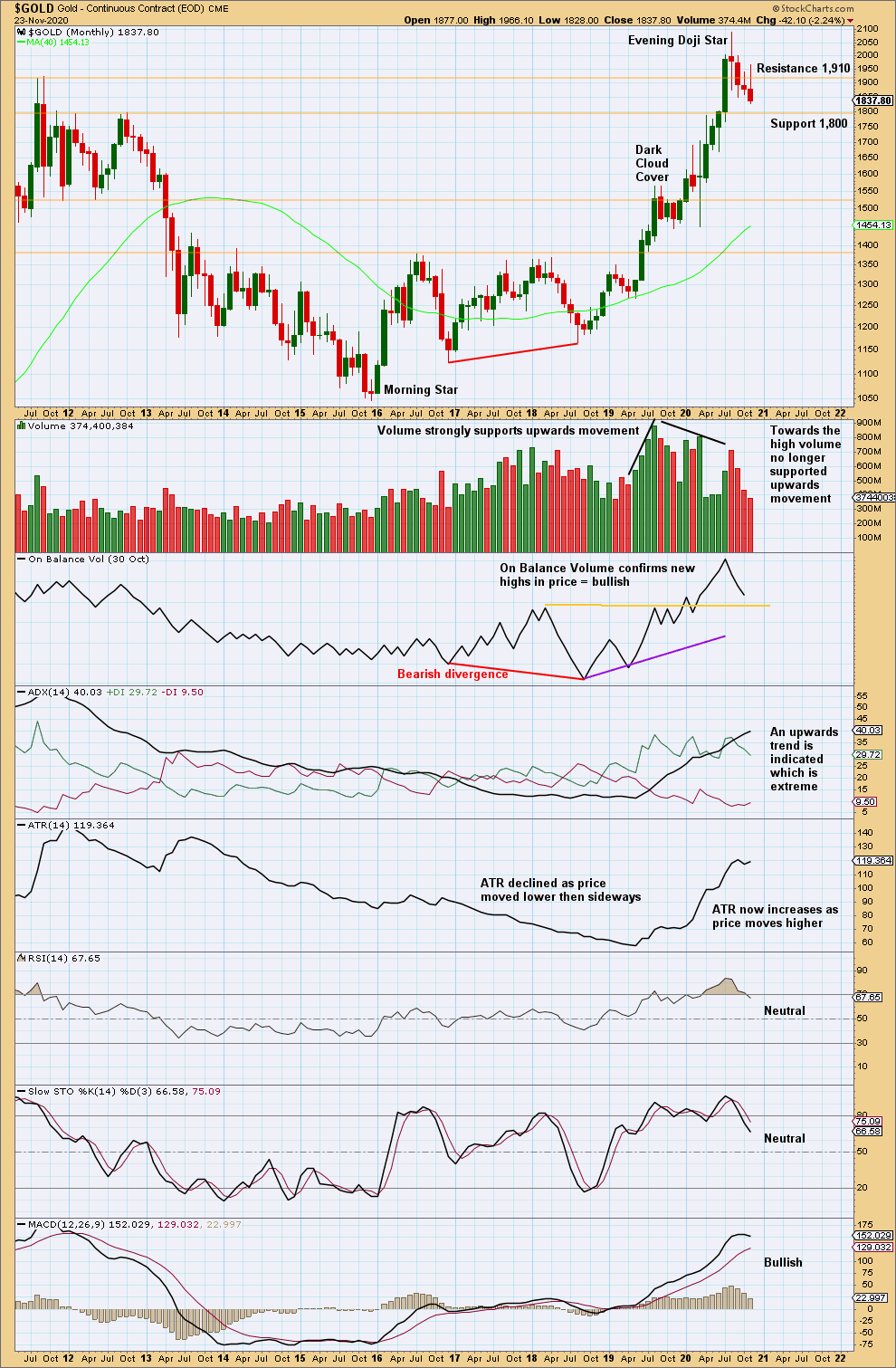
Click chart to enlarge. Chart courtesy of StockCharts.com.
There is a strong bearish candlestick pattern at the high. The third red candlestick in the pattern has support from volume.
For the short term, now price is falling of its own weight.
WEEKLY CHART
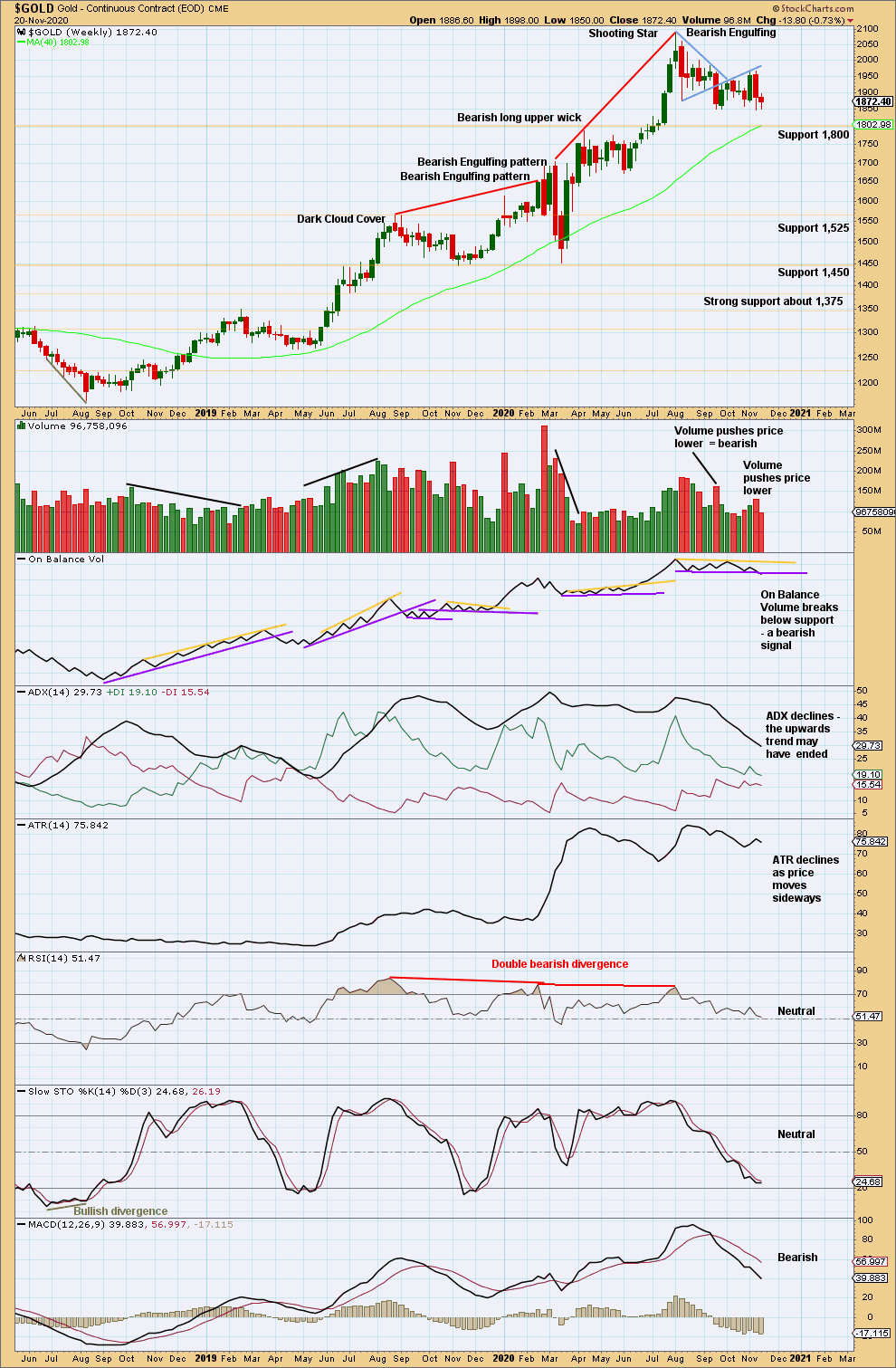
Click chart to enlarge. Chart courtesy of StockCharts.com.
At the last high were two bearish candlestick patterns with overbought RSI exhibiting double bearish divergence. It is possible there may have been a 180° trend change at the high. A new swing low below 1,671.70 would add confidence in that view.
Last week On Balance Volume breaks below support. The support line is reasonably long held and horizontal, but it has been tested only three prior times. The signal is a reasonable bearish signal. This, in conjunction with strong volume for downwards weeks and days, suggests a downwards breakout may be more likely than upwards.
DAILY CHART
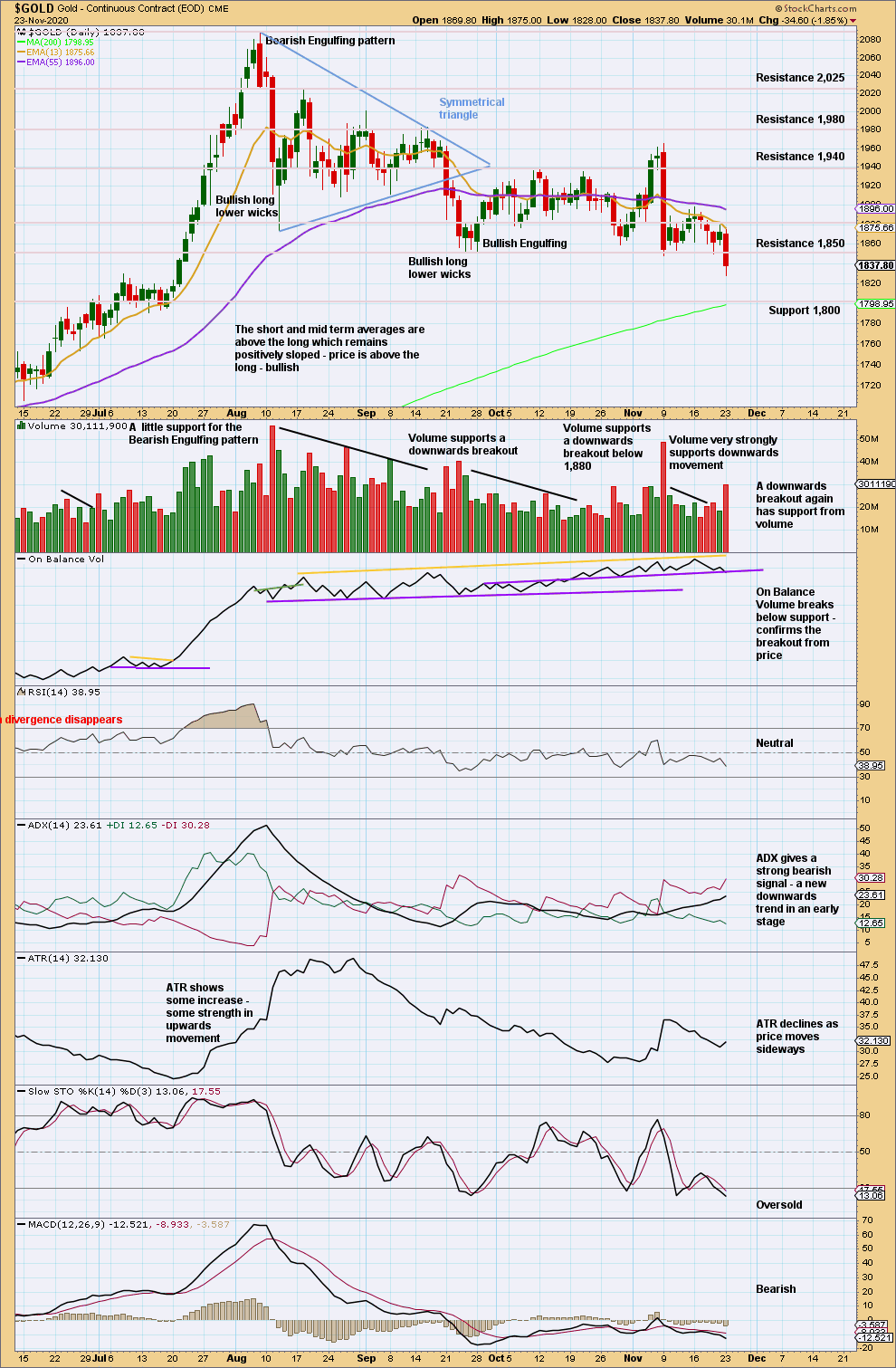
Click chart to enlarge. Chart courtesy of StockCharts.com.
Today price has closed below prior support at 1,850 on a downwards day with support from volume. Support at 1,850 now becomes resistance.
This chart supports the new main Elliott wave counts, both the first and second. There is a downwards trend in an early stage.
GDX WEEKLY CHART
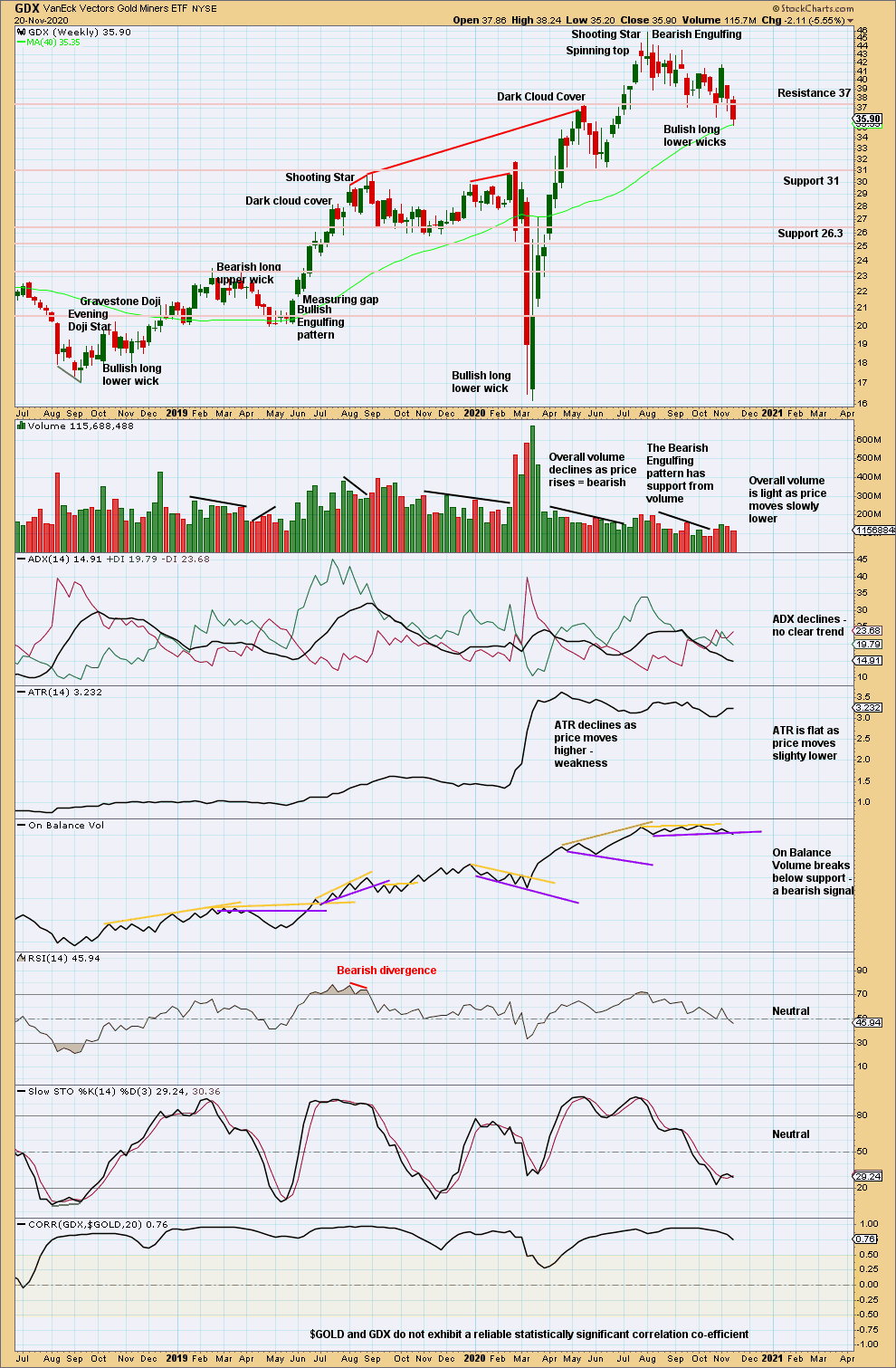
Click chart to enlarge. Chart courtesy of StockCharts.com.
A bearish signal from On Balance Volume this week also for GDX suggests more downwards movement ahead.
GDX DAILY CHART
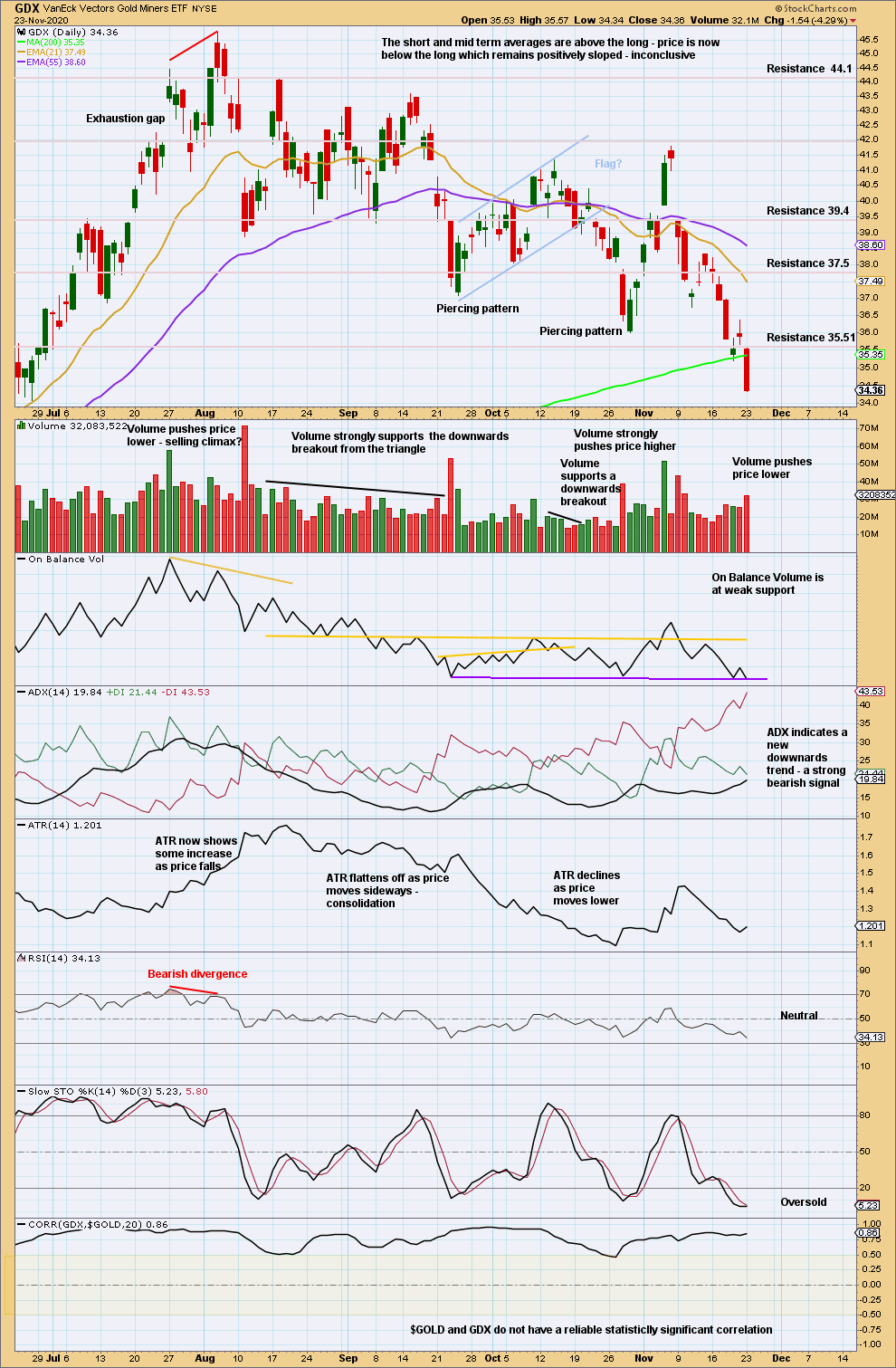
Click chart to enlarge. Chart courtesy of StockCharts.com.
Next support on the weekly chart is at 31.
Published @ 06:19 p.m. ET.
—
Careful risk management protects your trading account(s).
Follow my two Golden Rules:
1. Always trade with stops.
2. Risk only 1-5% of equity on any one trade.
—
New updates to this analysis are in bold.

